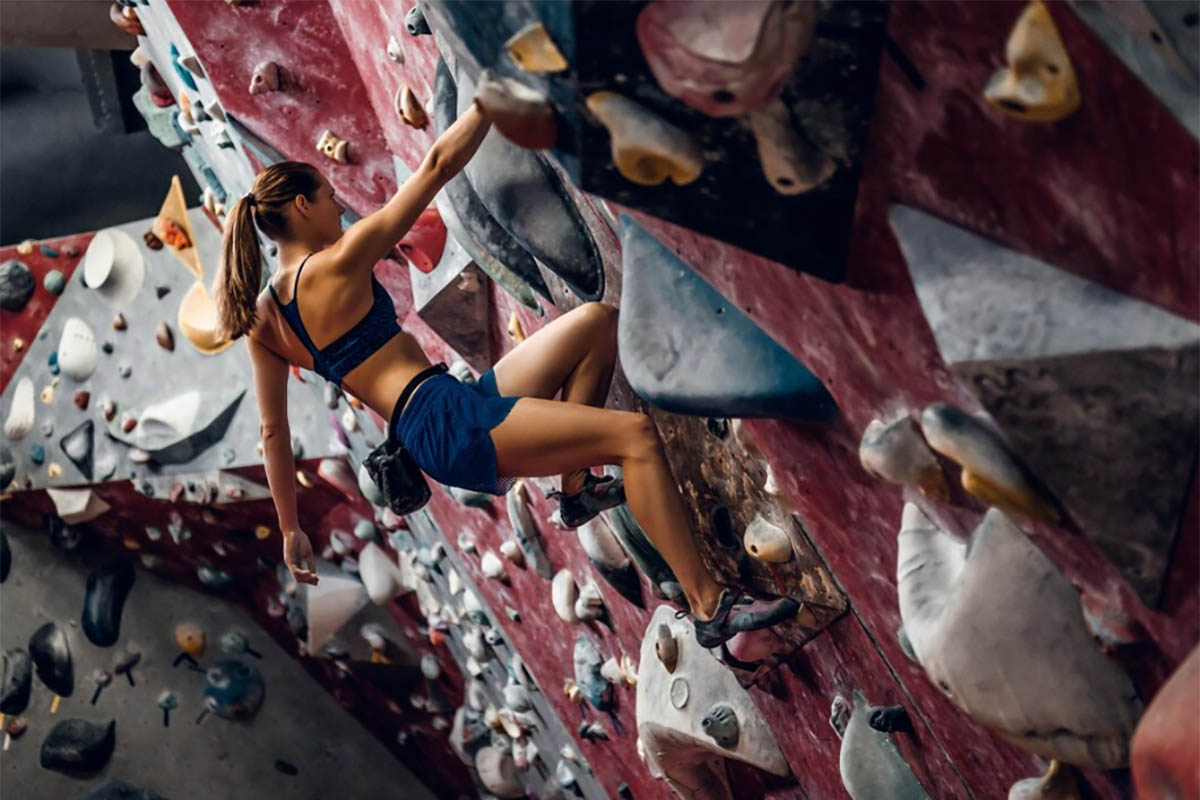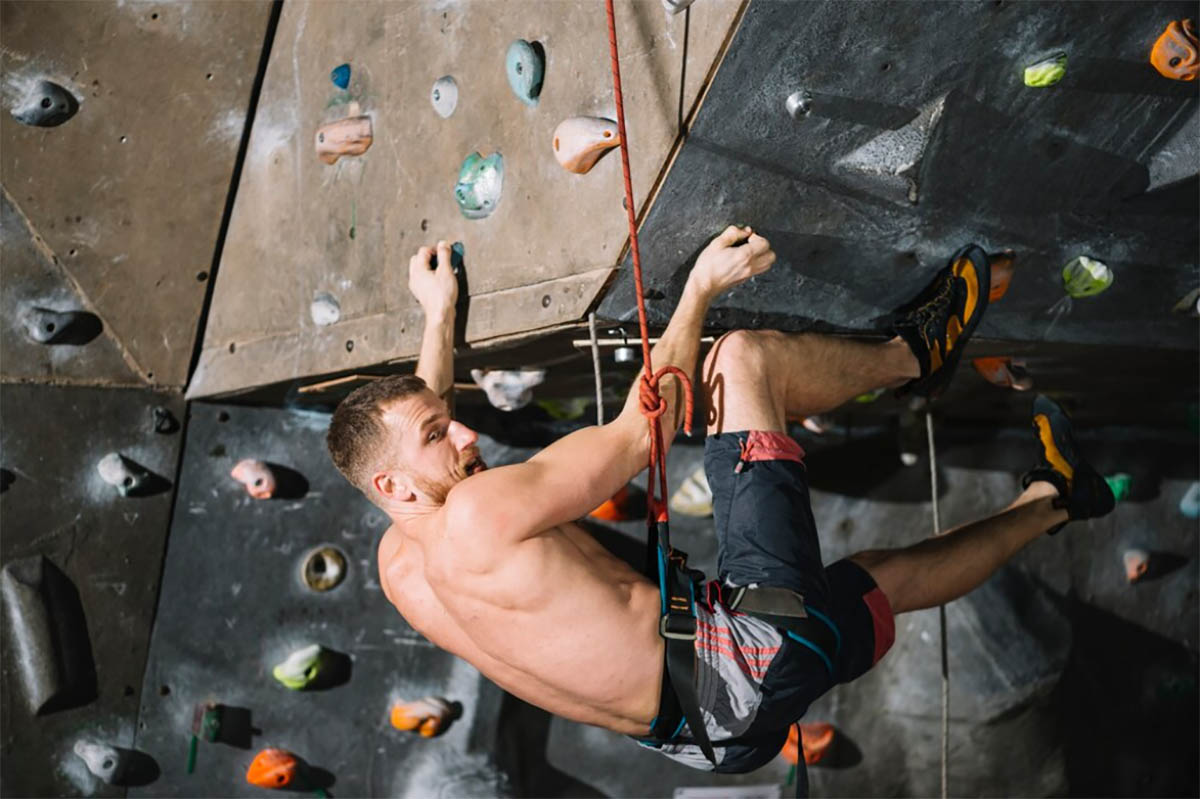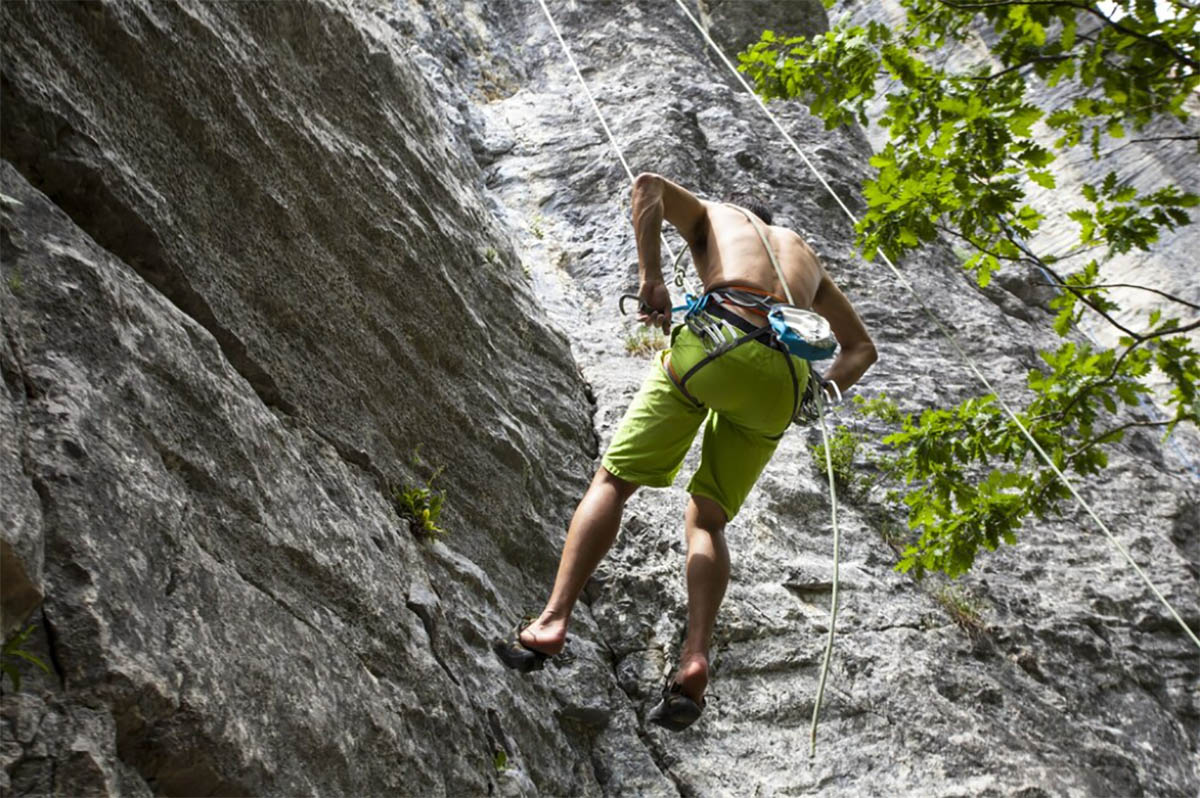Introduction
Rock climbing is a sport that demands not just mental fortitude but also a high level of physical fitness. Climbers often find themselves in need of strength, endurance, flexibility, and balance to navigate through challenging routes. Whether you’re an avid climber looking to get started in a climbing gym or an experienced climber aiming to improve your performance, incorporating a targeted workout regimen into your routine is crucial. This blog explores the best rock climbing exercises that focus on the key areas of fitness you need to conquer the cliffs and improve your rock climbing training and performance.
Importance Of Being Fit For Rock Climbing
Fitness in rock climbing transcends the conventional desire for a well-toned physique; it’s about preparing your body for the demands of climbing. Rock climbing involves pulling yourself up, stretching for distant holds, and often holding positions that require significant strength and endurance. A well-rounded fitness routine ensures you can tackle these challenges with reduced risk of injury, enabling longer, more enjoyable climbs, and the ability to attempt more difficult routes, especially during peak climbing time.
Warm-Up Exercises
Warming up before a climbing session in a climbing gym is vital to prepare your body for the physical exertion to come. It increases your heart rate, loosens up your muscles and joints, and reduces the risk of strains or injuries, thus optimizing your training for climbing. A proper warm-up can also improve your performance, as it prepares your muscles for the specific movements they will perform during climbing, enhancing both climbing technique and climbing volume.
Simple Stretching Exercises
Start your warm-up with simple stretching exercises to increase flexibility and range of motion. Focus on stretches that target the shoulders, arms, legs, and back, including the latissimus dorsi and shoulder blades, vital for maintaining climbing positions. Gentle, dynamic stretches are preferred over static stretches to prepare the body for the types of dynamic movements you’ll encounter while climbing.
Arm Circles and Wrist Stretches
Arm circles help loosen the shoulders and increase mobility, crucial for reaching and holding onto grips. Begin with small circles, gradually increasing in size. Follow with wrist stretches to prevent strains from gripping holds, thus enhancing forearm muscles and forearm strength. Extend one arm in front of you, palm facing down, and gently pull the fingers back with the other hand. Repeat with the palm facing up. Rest between sets is important to allow the muscles time to recover, following the rule of thumb for adequate rest times to maximize the benefits of these exercises.
Core Exercises

A strong core is the cornerstone of all rock climbers. It will determine if you have enough strength, support your body weight in various climbing positions, and facilitate powerful movements. It helps in maintaining body stability, transferring power between the upper and lower body, and supporting your body weight in various positions. Core strength allows climbers to make precise and controlled movements, minimize energy expenditure, and maintain balance on challenging routes. Core muscles are engaged in virtually every movement pattern in climbing, highlighting their importance in a climber’s training regimen.
Planks
Planks are one of the best exercises for rock climbing. These exercises target the entire abdominal region, lower back, and shoulders, crucial for maximum strength gains. To perform a basic plank:
- Lie face down on the floor.
- Raise yourself onto your elbows and toes, keeping your body in a straight line from head to heels.
- Engage your core and hold the position for 30 seconds to 1 minute.
Variations include side planks to target obliques, and raising one leg or arm to increase difficulty, which can also contribute to strength endurance. Incorporate rest between sets to ensure optimal performance and recovery time.
Leg Raises
Leg raises strengthen the lower abdominals and hip flexors, which are important for lifting legs to reach footholds and contributing to full-body workout benefits.
- Lie flat on your back with your legs straight.
- Slowly raise your legs to a 90-degree angle, keeping them straight.
- Lower them back down without touching the floor and repeat.
Perform 10-15 repetitions for 2-3 sets. Adjust rest times between sets according to your skill level to maximize strength gains without compromising recovery time.
Arm And Shoulder Exercises
Arm and shoulder strength is crucial for pulling oneself up on the rock, holding onto grips, and supporting the body’s weight during climbs. Strong arms and shoulders, particularly the latissimus dorsi and shoulder blades, increase endurance, allowing climbers to complete more challenging routes without fatiguing quickly. Rotator cuff strengthening exercises are particularly beneficial in this regard, as they enhance shoulder stability and can prevent common injuries among climbers. Implementing these exercises, often recommended in physical therapy, can significantly improve your climbing performance by ensuring your upper body is prepared for the rigorous demands of climbing.
Push-Ups
Push-ups strengthen the chest, shoulders, and triceps, contributing to the upper body strength essential for climbing.
- Start in a plank position with your hands slightly wider than shoulder-width apart.
- Lower your body until your chest nearly touches the ground.
- Push back up to the starting position.
Perform 3 sets of 10-15 repetitions. Rest between sets should be tailored to your training needs, allowing for adequate recovery time without hindering consecutive workouts.
Pull-Ups
Pull-ups are essential for developing grip strength, forearm strength, and upper body power, crucial elements for an avid climber’s performance.
- Hang from a pull-up bar with your hands shoulder-width apart, palms facing away from you.
- Pull yourself up until your chin is above the bar.
- Lower back down with control.
Work towards 3 sets of as many repetitions as you can perform, ensuring proper rest times between sets to foster recovery and strength gains. Sessions per week should be planned to allow for active recovery and avoid overtraining.
Leg Exercises
Leg strength is vital for pushing the body upwards, allowing climbers to utilize their lower body effectively to conserve arm strength and reach new heights. Strong legs contribute to a solid foundation, enhancing balance and stability on the rock, and are key for executing dynamic and powerful movements with precision. Training for climbing should include leg exercises to increase climbing volume and improve overall rock climbing performance.
Squats
Squats develop power in the quads, hamstrings, and glutes, offering a comprehensive lower-body workout that benefits climbers during prolonged periods of climbing.
- Stand with feet shoulder-width apart.
- Bend your knees and lower your body as if sitting back in a chair, keeping your chest up and back straight.
- Push through your heels to return to the starting position.
Aim for 3 sets of 10-15 repetitions, with rest times between sets adjusted based on your current fitness level and climbing goals. Adequate rest is essential to achieve maximum strength gains without overloading the muscles.
Lunges
Lunges target the thighs and glutes, important for stepping up on high footholds and maintaining climbing positions.
- Start standing with feet hip-width apart.
- Step forward with one leg and lower your hips until both knees are bent at about a 90-degree angle.
- Push back to the starting position and repeat on the other side.
Perform 10-15 lunges on each leg for 2-3 sets, considering appropriate rest between sets to allow for recovery. Including lunges in your training regimen enhances balance, strength, and flexibility, contributing to efficient movement patterns in climbing.
Finger And Grip Strength

The ability to grip tiny holds and endure long climbs without losing your grasp is directly linked to the strength of your fingers and forearms. Strong fingers and a robust grip can make the difference between holding on and slipping off, making grip strength exercises an indispensable part of a climber’s training regimen. Effective training for climbing focuses on enhancing maximum strength and strength endurance in the forearm muscles, vital for sustaining grip over extended periods.
Hangboard Exercises
A hangboard is a training tool that offers various grips to mimic rock holds, essential for developing grip strength and forearm strength.
- Start with basic dead hangs: Grip a comfortable hold with both hands, and feet off the ground, and hang for as long as possible while maintaining good form.
- Progress to shorter hangs with more challenging grips to increase strength.
Perform 3-5 sets of dead hangs, resting adequately between sets to ensure forearm muscles recover and adapt, leading to strength gains. Incorporate hangboard sessions into your training regimen for climbing, ideally 2-3 sessions per week, to improve grip strength progressively.
Grip Strength Exercises
- Rice Bucket: Fill a bucket with rice and plunge your hands in, opening and closing your fists. This exercise is excellent for building forearm strength and improving grip endurance.
- Rubber Bands: Place a rubber band around your fingers and thumb, then spread your fingers apart against the resistance. This simple exercise can be performed daily to improve grip strength and support climbing techniques gradually.
These exercises can be done daily to gradually improve grip strength, with minimal rest required between sets. They are ideal for active recovery days or as part of a full-body workout regimen that complements sessions at the climbing gym or bouldering wall.
Balance And Flexibility
Balance and flexibility enable climbers to reach and maintain difficult positions without falling. They allow for efficient movement on the rock, reducing the risk of injury by enabling dynamic motion and the ability to recover from slips or awkward positions. Training for climbing should incorporate exercises that enhance balance and flexibility, allowing climbers to perform dynamic and powerful movements with greater ease and precision. This not only improves climbing technique but also increases the climber’s ability to execute limited moves and navigate complex routes effectively.
Balance Drill 1: Slackline Training
Slacklining improves core strength, balance, and coordination, elements that are essential for maintaining stability during climbing. It mimics the balance required on a bouldering wall, making it an excellent training tool for climbers.
- Set up a slackline at a low height.
- Walk across it slowly, focusing on maintaining balance.
- As you improve, attempt turning and performing squats on the slackline.
Slackline training should be approached with caution, allowing adequate rest periods between attempts to prevent fatigue and ensure safety. Incorporating slackline training into your sessions per week can significantly enhance balance and core strength, contributing to improved climbing performance.
Balance Drill 2: Pistol Squats
Pistol squats enhance balance and leg strength, crucial for executing powerful movements and maintaining control in various climbing positions.
- Stand on one leg, with the other leg extended forward.
- Lower into a squat, keeping the extended leg straight.
- Rise back up and switch legs.
Start with assisted pistol squats if necessary, using support for balance. Including pistol squats in your training regimen promotes leg strength, balance, and flexibility, facilitating smoother movement patterns and greater efficiency on the rock. Rest times between sets should be optimized based on your fitness level and recovery needs, ensuring that each workout contributes positively to your climbing goals.
Cool Down And Recovery
Cooling down helps the body transition to a resting state, reducing muscle soreness and accelerating recovery. Gentle stretching and muscle relaxation are key to a proper cool-down routine, facilitating recovery time and preparing the body for subsequent training sessions. Effective cooling down practices are essential for climbers, especially after intensive training for climbing, as they help to mitigate the risk of injury and ensure the muscles are adequately rested and ready for the next workout.
Gentle Stretching
Engage in gentle stretching of all major muscle groups, focusing on areas worked during your climbing session. Hold each stretch for at least 30 seconds, avoiding bouncing or over-stretching. Gentle stretching aids in muscle recovery, increases flexibility, and decreases soreness, making it a critical component of any climber’s training regimen.
Tips For Muscle Recovery And Rest
- Hydration: Drink plenty of water to aid in muscle recovery and ensure the body is properly hydrated for peak climbing performance.
- Nutrition: Consume protein-rich foods to repair muscles and provide the energy needed for recovery and subsequent workouts.
- Rest: Ensure adequate sleep and rest days to allow muscles to recover fully. Active recovery practices, such as gentle yoga or walking, can also be beneficial in promoting muscle healing without overexerting the body.
Incorporating these recovery techniques into your climbing training regimen will help maintain your performance and reduce the risk of injury. Remember, the goal is to achieve a balance between training intensity and recovery time, allowing for strength gains and improvements in climbing technique without compromising overall health and well-being.
Conclusion
Incorporating these exercises into your training routine can significantly improve your rock climbing abilities. By focusing on strength, flexibility, and balance, climbers can prepare their bodies for the physical demands of the sport, leading to better performance and reduced injury risk. Remember, consistency is key to seeing progress, so integrate these exercises regularly into your workout schedule, paying close attention to the balance between training sessions and recovery time to maximize strength gains and enhance your climbing technique.
FAQs
What Exercises To Do For Rock Climbing?
Focus on exercises that build core strength, upper body strength, leg strength, and finger/grip strength, such as planks, pull-ups, squats, and hangboard workouts. Incorporating power exercises and movements that mimic climbing techniques can also be beneficial for improving rock climbing performance.
What Is The Best Way To Train For Climbing?
The best way to train for climbing involves a combination of specific strength training, balance and flexibility exercises, and actual climbing practice to apply and improve your skills. Tailoring your training regimen to your skill level, incorporating sessions per week at a climbing gym, and focusing on exercises that target the demands of climbing can lead to significant improvements in performance.
How Can I Practice Rock Climbing Without A Gym?
Use household items for grip strength exercises, practice balance drills like slacklining or yoga, and perform bodyweight exercises to build strength and flexibility. Climbing-specific workouts, such as hangboard training, can also be set up at home to improve grip strength and forearm muscles. Focusing on core exercises and dynamic movements can help mimic the physical demands of climbing, allowing for continued progress even without access to a climbing gym or bouldering wall.


